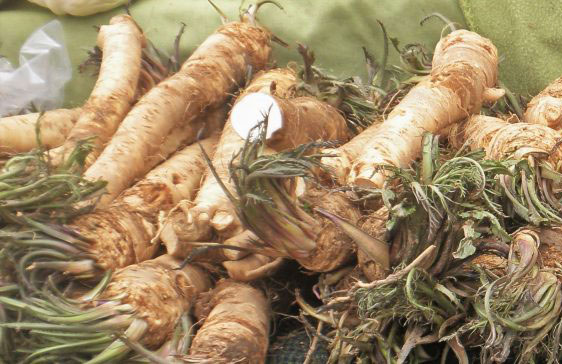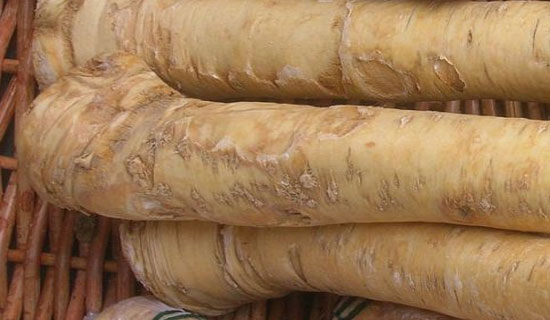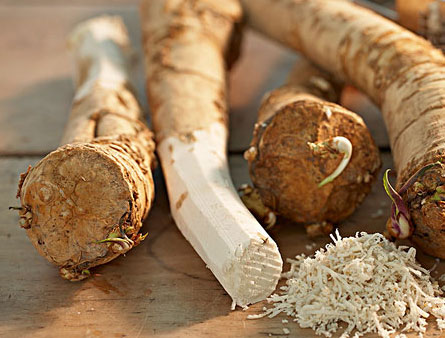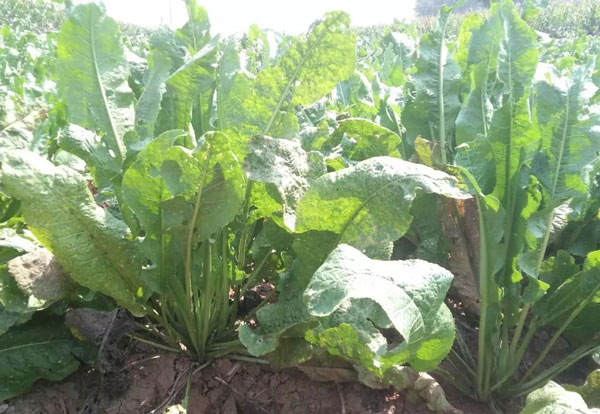Horseradish Plant (Armoracia Rusticana) Profile
Written by Iris
Oct 14 2021

Horseradish (Armoracia rusticana) is a perennial herb of the brassica mustard family, highly prized for the pungent taste of its edible root. Gardeners within 4 to 8 of the USDA plant hardiness zones can grow horseradish with little problem, but in warmer areas, these plants must be partially shaded. Root and crown cuttings are the only means of propagating horseradish, as these plants do not produce viable seeds. At the start of autumn, the cuttings will grow steadily during the winter months and the roots will be ready for harvest in the spring.

During the Middle Ages, both the leaves and roots were used as medicinal remedies. Horseradish's culinary value as a condiment on meats began taking shape in Germany, Scandinavia, and finally, Britain. It crossed the Atlantic Ocean to North America during colonial times.

You'll know your horseradish is ready when its root is about 1-inch in diameter. You can check one of your roots by gently digging it from the ground. Replant it if it needs some time to grow. Horseradish typically takes a full year after planting to become established enough for harvesting. However, once it's established, you should continue to have excellent growth each year.
To harvest horseradish, use a digging fork to loosen the soil in a circle around the plant. Then, use your fingers to determine the angle of the root, so you can more easily follow its path to dig around it. Use your fork to help you gently pull up on the root from underneath.
Wash off each root and let them dry completely. You can then store them in the refrigerator in a perforated bag, preferably in the vegetable crisper section, for about 3 months.
Additionally, anyone who has ever breathed or swallowed horseradish without knowing what it was in advance can attest to its sinus-clearing capacity. A spoonful of grated horseradish mixed with honey is a common recommendation for naturally clearing nasal congestion in a flash. Eating horseradish regularly reportedly boosts immunity to coughs, colds, and flu.
Horseradish flea beetle is a serious pest on foliage. It deposits egg clusters on leaf petioles (leafstalk). Its larvae burrow into the petioles and will kill some of the leaves. A floating row cover will help. Horticulture oils also have some repellent effect on this insect. Remember to read and follow the directions on all insecticides.
Horseradish Plant PictureHorseradish Plant InfoHorseradish Plant HistoryHow to Grow and Care for Horseradish PlantHow to Grow Horseradish PlantHow to Care for Horseradish PlantHarvesting and Storing HorseradishUses of HorseradishVarieties of HorseradishHorseradish Common Pests/DiseasesHorseradish Companion Plants
Horseradish Plant Picture

Horseradish Plant Info
| Botanical Name | Armoracia rusticana |
| Common Name | Horseradish, red cole, German mustard |
| Plant Type | Perennial herb |
| Mature Size | 12 to 18 inches tall; 15- to 18- inch spread |
| Exposure | Full sun to part sun |
| Soil Type | Loose, rich soil |
| Soil pH | Neutral (6.0 to 7.5) |
| Hardiness Zones | 3 to 9 (USDA) |
Horseradish Plant History
The aromatic roots of the horseradish plant have been prized for their medicinal and culinary properties for 3,000 years. According to Greek mythology, the Delphic Oracle described horseradish to Apollo, the God of medicine, as "worth its weight in gold." From ancient Egypt to mysterious Pompeii, early civilizations depicted horseradish in their art and writings. Used for thousands of years, horseradish is also counted amongst the five bitter herbs used in the Jewish celebration of the Passover Seder.During the Middle Ages, both the leaves and roots were used as medicinal remedies. Horseradish's culinary value as a condiment on meats began taking shape in Germany, Scandinavia, and finally, Britain. It crossed the Atlantic Ocean to North America during colonial times.

How to Grow and Care for Horseradish Plant
How to Grow Horseradish Plant
- Grow Horseradish Plant from Root Cuttings
- Grow Horseradish Plant from Crown Cuttings
How to Care for Horseradish Plant
- Light
- Soil
- Water
- Temperature
- Fertilizer
- Pruning

Harvesting and Storing Horseradish
For best flavor, horseradish should be harvested in cooler months, as cool soil helps to produce its pungent taste. The optimal time to harvest horseradish for most regions is in late fall through early spring. This also gives you a large window in which to harvest your horseradish, so you don't have to harvest a lot at one time and chance it spoiling.You'll know your horseradish is ready when its root is about 1-inch in diameter. You can check one of your roots by gently digging it from the ground. Replant it if it needs some time to grow. Horseradish typically takes a full year after planting to become established enough for harvesting. However, once it's established, you should continue to have excellent growth each year.
To harvest horseradish, use a digging fork to loosen the soil in a circle around the plant. Then, use your fingers to determine the angle of the root, so you can more easily follow its path to dig around it. Use your fork to help you gently pull up on the root from underneath.
Wash off each root and let them dry completely. You can then store them in the refrigerator in a perforated bag, preferably in the vegetable crisper section, for about 3 months.
Uses of Horseradish
Horseradish contains several essential nutrients, including potassium, calcium, magnesium, and phosphorus. In its raw state, horseradish boasts approximately 79.31 milligrams of vitamin C per 100 grams. Mustard oil is also present, which gives horseradish its antibacterial properties. Roots have been used to treat many conditions, including urinary tract infections, coughs and bronchitis, congestion, and even hangnails and ingrown toenails. Additionally, compounds present in the roots have been shown to kill some bacterial strains.Additionally, anyone who has ever breathed or swallowed horseradish without knowing what it was in advance can attest to its sinus-clearing capacity. A spoonful of grated horseradish mixed with honey is a common recommendation for naturally clearing nasal congestion in a flash. Eating horseradish regularly reportedly boosts immunity to coughs, colds, and flu.

Varieties of Horseradish
Common horseradish may be the only variety you will find. There is also Armoracia rusticana 'Variegata', which is more ornamental, with marbled leaves.Horseradish Common Pests/Diseases
The most common problem with horseradish is how to keep it from growing where you don't want it. It can become aggressive if not kept under control. To control the spread, remove the entire root, even the branches, when harvesting. Replant only the number of roots you want for the following season. Whatever you do, don't till up soil containing horseradish roots because you will risk spreading the plant all over the garden. Almost every little piece of root will sprout where it lies.Horseradish flea beetle is a serious pest on foliage. It deposits egg clusters on leaf petioles (leafstalk). Its larvae burrow into the petioles and will kill some of the leaves. A floating row cover will help. Horticulture oils also have some repellent effect on this insect. Remember to read and follow the directions on all insecticides.
Horseradish Companion Plants
Horseradish is thought to repel aphids and whiteflies, blister beetles, potato beetles, and some varieties of caterpillar. Its flowers attract beneficial predatory hoverflies.Latest Updated
- Benefits of Bugleweed - 7 Science-backed Health Benefits
- Bugleweed Dangers & Side Effects - Is It Poisonous?
- How to Plant Evergreen Trees - What You Should Know
- When to Plant Evergreens - Grow Guide for Evergreen Trees
- 12 Wonderful Evergreen Shrubs for Your Garden
- 12 Popular Evergreen Plants with Pictures for Beginners
- When And How To Prune A Lilac Bush Like a Pro
- How to Grow & Care for Lilac Vine (Hardenbergia Violacea)
- Japanese Lilac Tree (Syringa Reticulata) Care & Propagation Guide
- Shumard Oak Pros and Cons - What to Know
Popular Articles
- Winter maintenance of Antirrhinum Majus
- How to Grow Terminalia Mantaly Tree
- How to Grow and Care for Crossostephium Chinense
- How to grow Antirrhinum Majus in spring
- Peristeria Elata (Dove Orchid) Profile: Info & Care Guide
- Underwatered Snake Plant (Sansevieria Trifasciata) - Signs And How To Fix
- How to Care for Brazilian Jasmine Plant (Mandevilla Sanderi)
- How to Grow & Care for Graptopetalum Purple Delight in Summer
- Rosa Chinensis (China Rose): Plant Growing & Care Tips
- How to Care for Baby Sun Rose (Aptenia Cordifolia)